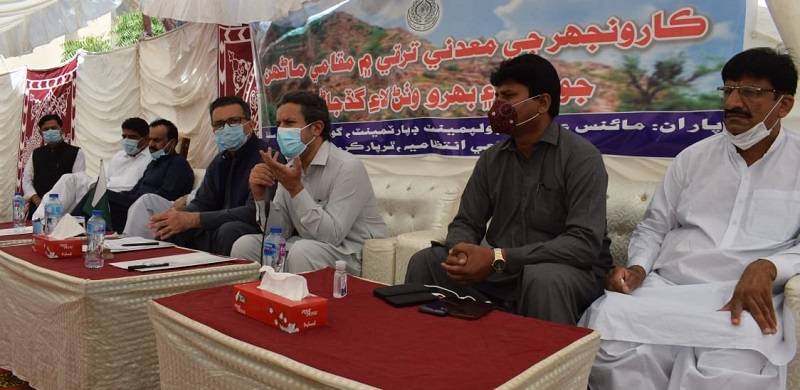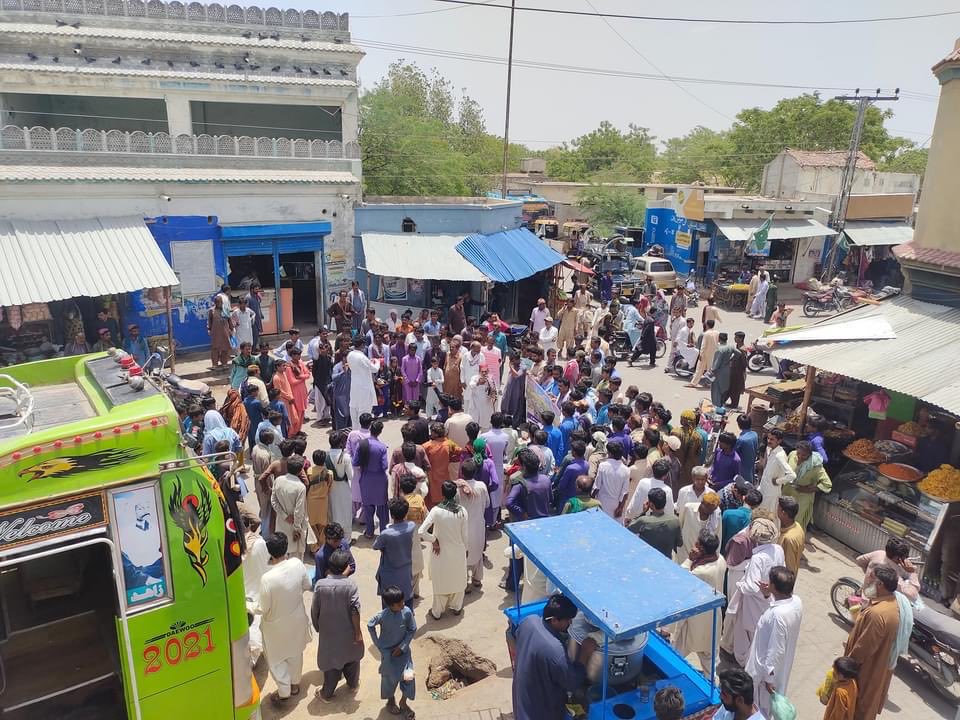
A large number of people from came on the roads in the hilly town of Nagarparkar to register their protest against the fresh extraction of granite stones from the Karoonjhar hills, on the call of the Karoonjhar Sujag Forum and Awami Tehreek. The protesters, after marching along various roads, gathered outside the local press club, where they staged a demonstration for several hours, speaking out against the fresh extraction of the stone and the construction of small dams.
Allah Rakhio Khoso, Zulfikar Ali Khoso, Ghulam Mustafa Dal, Ramesh Karoonjhari and other leaders of the protesters talking to the media, deplored the fact that contractors were not being prevented from their activities of extracting and using the same stone in the construction of small dams to store rainwater during the monsoon season, despite more than sufficient rainfall. The protesters said that practice of extraction with the help of heavy machinery was going on unchecked at Kharsar and other points, despite the fact that a double bench of the Sindh High Court had imposed a complete ban on mining and extraction from any points of the hills in the entire Parkar reign. They said that one of their leaders Allah Rakhio Khoso, through his counsel Advocate Ghulam Mustafa Hingorjo, had filed that petition and the court, after directing the high-ups of Sindh province to form a committee comprising of experts, had also banned such extraction activities few years back.
 Protesters claimed that the beautiful hills of Karoonjhar are of great, cultural, religious and historical significance, and that as many as 106 had already been declared sacred sites due to the presence of Jain temples and other religious structures. Moreover, argued the protesters, monuments dedicated to historic and folk heroes like Roplo Kolhi, who had laid down their lives by fighting British colonial invaders, were to be found in this region. Leaders of the protesters said that construction of more dams was not only damaging such historical sites, but was also creating environmental issues in the region.
Protesters claimed that the beautiful hills of Karoonjhar are of great, cultural, religious and historical significance, and that as many as 106 had already been declared sacred sites due to the presence of Jain temples and other religious structures. Moreover, argued the protesters, monuments dedicated to historic and folk heroes like Roplo Kolhi, who had laid down their lives by fighting British colonial invaders, were to be found in this region. Leaders of the protesters said that construction of more dams was not only damaging such historical sites, but was also creating environmental issues in the region.
The protesters said that they had already been pleading that there was no need to construct more small dams, since that practice would adversely affect the natural seepage of water and result in the destruction of local aquifers, depriving the people of the region of the possibility of obtaining water from wells. They said that high-ups of the Sindh government, without having carried out studies of alternative venues, were recklessly constructing dams on the recommendations of local lawmakers. These political figures were, according to the protesters, directly involved in getting kickbacks by awarding contracts to their favourite “blue-eyed persons.”
If such extractive and environmentally harmful activities were not halted in accordance with the judiciary’s directives, the leaders warned that they would expand the scope of their protests. People from various backgrounds also took to social media with the hashtag of #SaveKaroonjhar and demanded that Sindh authorities take action to prevent the extraction of these stones from the hills.
Allah Rakhio Khoso, Zulfikar Ali Khoso, Ghulam Mustafa Dal, Ramesh Karoonjhari and other leaders of the protesters talking to the media, deplored the fact that contractors were not being prevented from their activities of extracting and using the same stone in the construction of small dams to store rainwater during the monsoon season, despite more than sufficient rainfall. The protesters said that practice of extraction with the help of heavy machinery was going on unchecked at Kharsar and other points, despite the fact that a double bench of the Sindh High Court had imposed a complete ban on mining and extraction from any points of the hills in the entire Parkar reign. They said that one of their leaders Allah Rakhio Khoso, through his counsel Advocate Ghulam Mustafa Hingorjo, had filed that petition and the court, after directing the high-ups of Sindh province to form a committee comprising of experts, had also banned such extraction activities few years back.
 Protesters claimed that the beautiful hills of Karoonjhar are of great, cultural, religious and historical significance, and that as many as 106 had already been declared sacred sites due to the presence of Jain temples and other religious structures. Moreover, argued the protesters, monuments dedicated to historic and folk heroes like Roplo Kolhi, who had laid down their lives by fighting British colonial invaders, were to be found in this region. Leaders of the protesters said that construction of more dams was not only damaging such historical sites, but was also creating environmental issues in the region.
Protesters claimed that the beautiful hills of Karoonjhar are of great, cultural, religious and historical significance, and that as many as 106 had already been declared sacred sites due to the presence of Jain temples and other religious structures. Moreover, argued the protesters, monuments dedicated to historic and folk heroes like Roplo Kolhi, who had laid down their lives by fighting British colonial invaders, were to be found in this region. Leaders of the protesters said that construction of more dams was not only damaging such historical sites, but was also creating environmental issues in the region.The protesters said that they had already been pleading that there was no need to construct more small dams, since that practice would adversely affect the natural seepage of water and result in the destruction of local aquifers, depriving the people of the region of the possibility of obtaining water from wells. They said that high-ups of the Sindh government, without having carried out studies of alternative venues, were recklessly constructing dams on the recommendations of local lawmakers. These political figures were, according to the protesters, directly involved in getting kickbacks by awarding contracts to their favourite “blue-eyed persons.”
If such extractive and environmentally harmful activities were not halted in accordance with the judiciary’s directives, the leaders warned that they would expand the scope of their protests. People from various backgrounds also took to social media with the hashtag of #SaveKaroonjhar and demanded that Sindh authorities take action to prevent the extraction of these stones from the hills.

